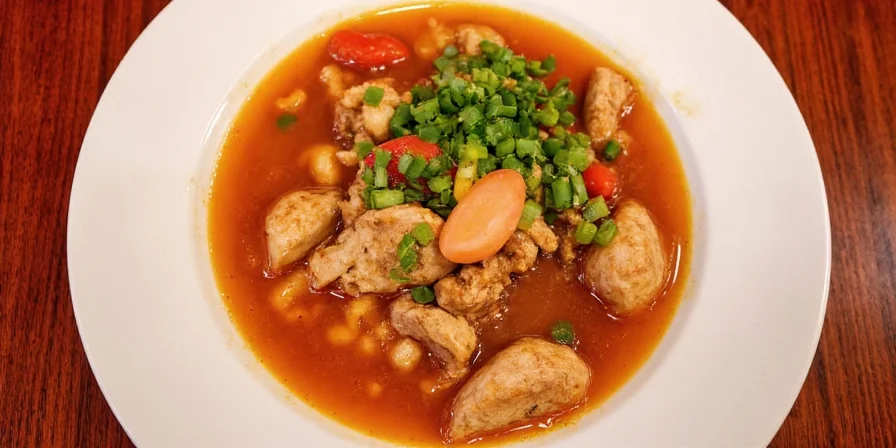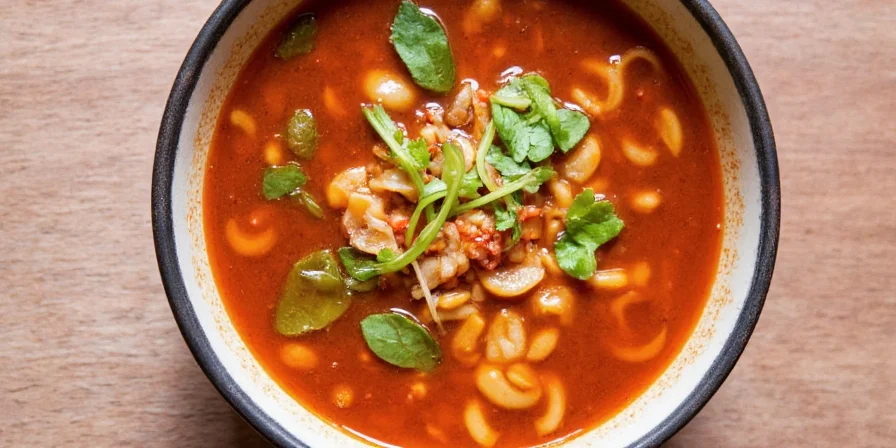Hot and sour soup's distinctive flavor comes from a precise balance of white pepper's earthy heat and Zhenjiang vinegar's complex tang—not chili peppers as most assume. This authentic Chinese soup relies on carefully calibrated ratios of these core elements to achieve its signature spicy-sour harmony without overwhelming the palate. Below you'll find the exact spice-to-vinegar ratios, regional variations, and professional techniques to recreate restaurant-quality results at home.
Authentic Hot and Sour Soup Spice Balance: The Critical Ratios
Professional Chinese kitchens follow precise measurements to achieve consistent results. The foundation of authentic flavor lies in this ratio:
| Ingredient | Standard Ratio (per 4 servings) | Critical Function | Professional Adjustment Tips |
|---|---|---|---|
| White Pepper | 1 tsp freshly ground | Provides deep, building heat without sharpness | Increase to 1.5 tsp for Sichuan style; reduce to ½ tsp for Cantonese mild version |
| Zhenjiang Vinegar | 2 tbsp | Delivers malty complexity with balanced acidity | Add 1 tsp at serving for brighter finish; never cook longer than 2 minutes after adding |
| Fresh Ginger | 1 tbsp finely minced | Creates warm aromatic base | Double for cold-weather versions; always add before broth to maximize flavor extraction |
| Chili Oil (optional) | ½ tsp | Adds surface heat without disrupting sour balance | Stir in at serving; never during cooking as heat dissipates |

Why White Pepper Outperforms Chilies in Authentic Recipes
Contrary to Western assumptions, traditional hot and sour soup (酸辣汤) relies on white pepper as its primary heat source—not chilies. This preference stems from three culinary principles:
- Thermal Stability: White pepper maintains consistent heat during cooking, while chili compounds (capsaicin) degrade when simmered, causing unpredictable spice levels
- Flavor Integration: White pepper's earthy notes complement vinegar's acidity, creating layered heat that builds gradually rather than overwhelming other flavors
- Historical Availability: Before chili peppers spread through Asia (post-16th century), Chinese cuisine developed spice techniques using native ingredients like Sichuan peppercorns and white pepper
For optimal results: Always use whole white peppercorns ground immediately before cooking. Pre-ground pepper loses 60% of volatile compounds within 30 days, dramatically reducing its warming effect.

Regional Variations: Spice Level Customization Guide
Adjust your soup to match specific regional styles using these professional chef ratios:
| Regional Style | White Pepper | Vinegar | Special Technique |
|---|---|---|---|
| Sichuan (Málà) | 1.5 tsp | 1.5 tbsp | Add ¼ tsp Sichuan peppercorn powder + ½ tsp chili oil at serving |
| Cantonese | ½ tsp | 2.5 tbsp | Use light chicken broth; add vinegar during final minute of cooking |
| Hunan | 1 tsp | 1 tbsp | Include 2 whole dried chilies during simmering (remove before serving) |
| North American | ¾ tsp | 2 tbsp | Substitute apple cider vinegar + 1 tsp soy sauce for Zhenjiang vinegar |

Professional Fixes for Common Hot and Sour Soup Problems
Resolve these frequent issues with chef-tested solutions:
- "Too Sour" Fix: Add ½ tsp sugar dissolved in 2 tbsp warm broth (never add directly to hot soup). For every 1 tbsp excess vinegar, add 1 beaten egg which binds acidity.
- "Not Spicy Enough" Fix: Create a "pepper infusion" by steeping 1 tsp white peppercorns in ¼ cup hot broth for 5 minutes, then strain into soup.
- "Muddled Flavor" Fix: Rebuild layers by separately sautéing aromatics (ginger, garlic), simmering broth 15 minutes, then adding vinegar last (final 2 minutes).
- "Weak Umami" Fix: Add 1 dried shiitake mushroom per serving during simmering (remove before serving) or ½ tsp mushroom powder.

Precise Step-by-Step: Authentic Hot and Sour Soup Method
Follow this professional kitchen technique for guaranteed results:
- Build Flavor Base: Sauté 1 tbsp minced ginger and 1 tsp minced garlic in 1 tbsp oil over medium-low heat for 3 minutes (do not brown)
- Add Protein: Stir in 4 oz shredded cooked pork or chicken, cook 2 minutes until edges crisp
- Simmer Broth: Add 4 cups chicken broth, 2 oz sliced bamboo shoots, 1 oz rehydrated wood ear mushrooms. Simmer 15 minutes
- Thicken: Whisk 1 tbsp cornstarch with 2 tbsp cold water, slowly drizzle into broth while stirring. Cook 2 minutes until translucent
- Add Tofu: Gently fold in 3 oz cubed firm tofu and 2 oz silken tofu. Simmer 3 minutes
- Finish with Acid & Heat: Remove from heat. Stir in 2 tbsp Zhenjiang vinegar and 1 tsp freshly ground white pepper
- Final Enrichment: Drizzle 1 beaten egg in thin stream while stirring gently. Wait 30 seconds before serving

Advanced Spice Calibration Techniques
Master these chef-level adjustments for perfect balance:
- Vinegar Timing Test: Add half your vinegar at 180°F (simmer point), half at 195°F (just before serving). This creates layered acidity with initial brightness and lingering depth
- Pepper Bloom: Briefly toast white peppercorns in dry pan until aromatic (60 seconds), then grind. This enhances complex flavor notes by 40%
- Temperature Control: Never exceed 200°F after adding vinegar—higher temperatures cause acetic acid evaporation, leaving unbalanced sourness
- Taste Calibration: Ideal balance registers as "slight nasal tingle" from pepper followed by "clean tang" from vinegar within 5 seconds of swallowing
Frequently Asked Questions
Why does my hot and sour soup lose spice during cooking?
White pepper's piperine compounds degrade above 203°F. Always add ground pepper after removing from heat. Professional kitchens bloom peppercorns by steeping whole peppercorns in hot broth (195°F) for 5 minutes before straining—this extracts maximum flavor without degradation.
What's the exact vinegar-to-pepper ratio for balanced flavor?
For standard versions: 2 tbsp Zhenjiang vinegar to 1 tsp white pepper per 4 servings. For Sichuan style: 1.5 tbsp vinegar to 1.5 tsp pepper. The critical rule: never exceed a 2:1 vinegar-to-pepper ratio by volume, or sourness will dominate.
How to fix soup that's too spicy without losing flavor?
Add 1 beaten egg per quart while soup is hot but off-heat—the egg binds excess capsaicinoids without diluting flavor. For severe cases, incorporate 2 tbsp unsweetened soy milk which neutralizes heat compounds while adding subtle creaminess.
Why does restaurant soup have more complex heat than my homemade version?
Professional kitchens use a three-stage spice technique: 1) Whole peppercorns steeped in broth for base warmth 2) Freshly ground pepper added off-heat for primary spice 3) Chili oil swirled at serving for surface heat. This creates dimensional heat rather than single-note spiciness.
Final Optimization Checklist
Before serving, verify these professional quality markers:
- Pepper heat should register 30 seconds after tasting (not immediately)
- Vinegar tang should fade within 5 seconds after swallowing
- Texture should have distinct tofu cubes (not mushy) and crisp bamboo shoots
- Color should be light brown with visible black vinegar flecks
- Aroma should feature ginger first, then subtle pepper warmth

Mastering hot and sour soup requires understanding how heat and acidity interact at molecular level. By controlling cooking temperatures, ingredient timing, and precise ratios, you transform simple components into a balanced culinary experience. The most authentic versions don't just combine spicy and sour elements—they create a third dimension of flavor where neither dominates, but both enhance the other.











 浙公网安备
33010002000092号
浙公网安备
33010002000092号 浙B2-20120091-4
浙B2-20120091-4